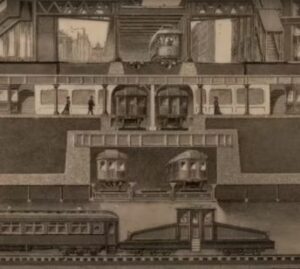|
The digital revolution has changed our methods of approach to historical preservation, education, and research. New instruments are developing to help academics, researchers, and students simplify their jobs as artificial intelligence advances at an unheard-of speed. One such creative instrument transforming historical study and academic writing is the AI thesis statement tool. Within Brooklyn’s rich transit legacy and railway preservation, AI-driven tools—including the AI thesis builder and online AI thesis statement writers—can be very important in guaranteeing the smooth documentation, analysis, and promotion of transit legacy. AI in Historical Research: A Modern BreakthroughThe contribution of artificial intelligence to historical study is fast expanding. Traditional historical study sometimes calls for several hours of archival investigation, source cross-referencing, and well-organized argument development. But by offering structured thesis statements through a thesis generator to help researchers, creating outlines, and even suggesting pertinent sources, AI-powered technologies like AI thesis statement generators can help researchers. For historians and aficionados of Brooklyn’s subway system, this can be especially helpful since it will enable them to more easily create convincing arguments regarding its historical importance.
For instance, a historian looking at the Atlantic Avenue Tunnel—the oldest subway tunnel in the world—might try to create a compelling argument on how it affected urban mobility. Synthesizing enormous volumes of data and creating a statement such as “The Atlantic Avenue Tunnel served as a pioneering infrastructure project that laid the foundation for modern subway systems, demonstrating the interplay between technical advancement and urban development,” an AI generator could assist. In addition to saving time, this guarantees that researchers keep a clear and orderly concentration in their work. Preserving Brooklyn’s Railway History with AI-Powered ResearchBrooklyn’s historic rail networks are committedly preserved and promoted by the Brooklyn Historic Railway Association (BHRA). Preserving these transportation systems and their socio-economic influence adequately recording and explaining their relevance presents one of the difficulties. AI thesis generators can enable the creation of stories that reflect the historical core of these transit lines, therefore enabling access to both academics and the general people. For instance, suppose a researcher wants to argue that trolley systems played a crucial role in Brooklyn’s urbanization. Key historical events entered into an AI thesis generator will produce an exact and well-organized thesis such as “Brooklyn’s trolley systems were instrumental in shaping the borough’s economic growth and connectivity, so serving as a precursor to modern-day urban transportation models.” Such AI-assisted theses can direct more investigation, producing informative papers, reports, and even museum exhibitions. AI Generators and the Future of Urban Transit AdvocacyBeyond scholarly study, AI writers can also be helpful for public transit restoration advocacy campaigns. Advocacy organizations sometimes have to provide striking written materials like proposals, funding applications, and informational pieces. Writing tools driven by artificial intelligence can assist in clearly and persuasively organizing these papers. An AI generator could help the BHRA create a proposal with a central argument like: “Restoring Brooklyn’s historic trolley lines will not only preserve a crucial element of the city’s cultural legacy but also provide a sustainable and community-driven transportation alternative.” If the BHRA is seeking money for a new trolley restoration project, for instance. This methodical strategy can help advocacy tools be more successful, so raising the possibility of obtaining support and money. Enhancing Public Engagement with AI-Generated ContentEngaging a current audience is one of the difficulties for historical preservation. Younger generations, used to digital content, may search for interactive and quickly absorbed knowledge. AI-powered tools—including AI thesis generators—can help to produce interesting blog entries, social media materials, and instructional resources bringing Brooklyn’s railway past to life. An AI writer might, for example, assist in shaping material for an article on the development of Brooklyn’s transportation system by providing a thesis like, “Brooklyn’s transit evolution, from horse-drawn streetcars to electrified trolleys, mirrors the broader trends of urban expansion and technological progress in the United States.” Using this basis, writers of content can create an interesting story that appeals to casual readers as well as historical buffs. AI’s Limitations and the Need for Human OversightWhile AI generators are powerful tools, they are not without limitations. Artificial intelligence cannot grasp complex historical settings, have human intuition, or be creative. Therefore, even if an AI bot can offer a disciplined argument, it is up to historians, scholars, and authors to improve the material, include historical depth, and guarantee factual truth. AI might, for example, create a thesis on Brooklyn’s transportation past without taking sociopolitical elements influencing its growth into account. To produce a comprehensive study, a historian must arrange this material using primary sources, historical narratives, and professional interpretations. Content created by AI should also always be fact-checked to stop errors from proliferating. Although artificial intelligence can process enormous volumes of data, occasionally it will oversimplify or misinterpret historical events. This emphasizes how crucial human supervision is to guarantee that research supported by artificial intelligence keeps high intellectual and factual standards. Integrating AI Thesis Generators into Research and EducationEducational institutions, museums, and historical societies can benefit immensely from integrating AI generators into their research and writing processes. For students researching transportation history, these resources can be great allies in developing coherent arguments and organized writings. For a paper on the effects of streetcars on Brooklyn’s neighborhoods, for instance, a student might create a central argument like “The expansion of streetcar networks in Brooklyn catalyzed the borough’s residential growth, enabling greater mobility and economic diversification.” using an AI thesis writer. Students can investigate the subject further using this basic thesis and use first-hand narratives, newspaper archives, and historical maps to bolster their arguments. AI can also help museum curators create instructional resources and exhibit descriptions that let guests access transit histories. An AI-generated thesis about the legacy of Brooklyn’s elevated rail lines might read: “The rise and fall of Brooklyn’s elevated rails reflect broader shifts in urban planning and transit preferences, so shaping the city’s transportation scene into the modern era”. Such concise and structured content can enhance visitor engagement and learning experiences. The Road Ahead: AI and the Future of Historical DocumentationThe use of artificial intelligence in historical research and urban transportation preservation will only grow as its development proceeds. When used sensibly, AI bots can improve public outreach, academic writing, and transportation advocacy’s efficiency and efficacy. Still, cooperation is the secret to a good integration. AI should assist human researchers rather than replace them; it should be a tool that improves their capacity to record, examine, and distribute historical narratives. Organizations like the BHRA can keep meaningfully and creatively maintaining Brooklyn’s transit legacy by combining AI-driven efficiency with human knowledge and enthusiasm. All things considered, AI thesis generators are a great tool for teachers, academics, and transit activists. AI writing tools have great future possibilities for the preservation of transit history whether they are applied for creating convincing historical arguments, modifying advocacy materials, or public engagement. By carefully balancing artificial intelligence help with human insight, we can make sure Brooklyn’s rich railway legacy stays a vital component of our shared memory for the next generations.
|

